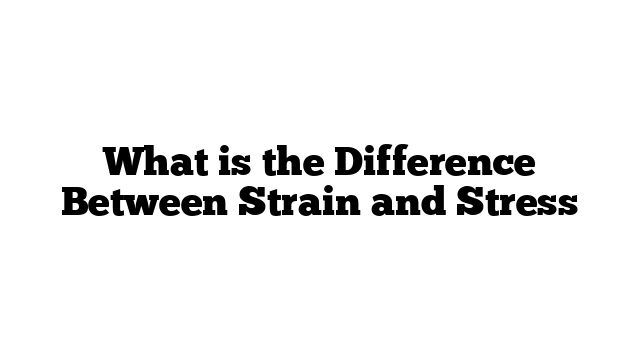Introduction:
In the field of physics, stress and strain are two important concepts that describe the behavior of materials when subjected to external forces. While these terms are often used interchangeably, they have distinct meanings and implications. This article aims to clarify the difference between stress and strain, providing a comprehensive understanding of their definitions and applications.
What is Stress?
Stress, in physics, refers to the force applied to an object per unit area. It is the external force that acts on a material, causing it to deform or change its shape. Stress is measured in units of force divided by area, such as pascals (Pa) or newtons per square meter (N/m²). The magnitude of stress indicates the intensity of the force being exerted on the material.
Types of Stress:
There are different types of stress that can be applied to a material:
1. Tensile Stress: Tensile stress is the stress that tends to stretch or elongate a material along its length. It occurs when a force is applied in opposite directions, trying to pull the material apart.
2. Compressive Stress: Compressive stress is the stress that tends to compress or shorten a material along its length. It occurs when a force is applied in opposite directions, trying to push the material together.
3. Shear Stress: Shear stress is the stress that causes one layer of a material to slide or deform relative to another layer parallel to it. It occurs when a force is applied parallel to the surface of the material.
What is Strain?
Strain, on the other hand, refers to the deformation or change in shape that occurs in a material when stress is applied. It is a measure of how much a material stretches or deforms under the influence of stress. Unlike stress, strain is a dimensionless quantity and does not have a specific unit of measurement.
Types of Strain:
Similar to stress, there are different types of strain that can be observed in a material:
1. Tensile Strain: Tensile strain is the strain that occurs when a material is stretched or elongated along its length due to tensile stress. It is measured as the change in length divided by the original length of the material.
2. Compressive Strain: Compressive strain is the strain that occurs when a material is compressed or shortened along its length due to compressive stress. It is measured as the change in length divided by the original length of the material.
3. Shear Strain: Shear strain is the strain that occurs when layers of a material slide or deform relative to each other due to shear stress. It is measured as the change in shape divided by the original shape of the material.
Relationship between Stress and Strain:
The relationship between stress and strain is described by Hooke’s Law, which states that the stress applied to an elastic material is directly proportional to the strain produced. In other words, for small deformations within the elastic limit of a material, stress and strain are linearly related.
Beyond the elastic limit, when the material undergoes plastic deformation, the relationship between stress and strain becomes nonlinear. At this point, the material may experience permanent deformation or even failure.
Applications:
The understanding of stress and strain is crucial in various fields, including engineering, materials science, and structural analysis. Engineers and designers use stress and strain calculations to ensure the safety and durability of structures, machines, and components. By analyzing stress and strain distributions, they can determine the optimal design and materials for specific applications.
Conclusion:
In summary, stress and strain are fundamental concepts in physics that describe how materials respond to external forces. Stress is the force applied per unit area, while strain is the resulting deformation or change in shape. Understanding the difference between stress and strain is essential in the design and analysis of structures and materials. By considering stress and strain, engineers can ensure the integrity and functionality of various systems and components.
